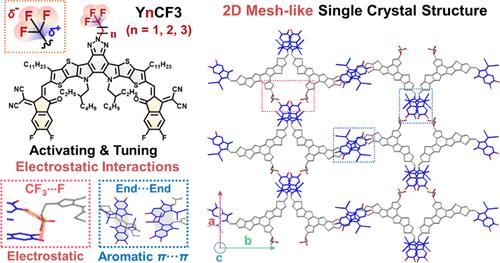CF3-Functionalized Side Chains in Nonfullerene Acceptors Promote Electrostatic Interactions for Highly Efficient Organic Solar Cells
IF 15.6
1区 化学
Q1 CHEMISTRY, MULTIDISCIPLINARY
引用次数: 0
Abstract
The advent of next-generation nonfullerene acceptors (NFAs) has propelled major advances in organic solar cells (OSCs). Here we report an NFA design incorporating CF3-terminated side chains having varying N-(CH2)n-CF3 linker lengths (n = 1, 2, and 3) which introduce new intermolecular interactions, hence strong modulation of the photovoltaic response. We report a systematic comparison and contrast characterization of this NFA series with a comprehensive set of chemical/physical techniques versus the heavily studied third-generation NFA, Y6, revealing distinctive and beneficial properties of this new NFA series. Single-crystal diffraction analyses reveal unusual two-dimensional mesh-like crystal structures, featuring strong interactions between the side chain CF3-terminal and NFA core F substituents. These atomistic and morphological features contribute to enhanced charge mobility and significantly enhanced photovoltaic performance. We show that varying the CF3-terminated side chain linker length strongly modulates light harvesting efficiency as well as charge recombination and the photovoltaic bandgap. The CF3-(CH2)2-based OSC demonstrates the most balanced performance metrics, achieving a remarkable 19.08% power conversion efficiency and an exceptional 80.09% fill-factor. These results imply that introducing CF3-terminated side chains into other OSC conjugated constituents may accelerate next-generation solar cell development.

非富勒烯受体中cf3功能化侧链促进了高效有机太阳能电池的静电相互作用
下一代非富勒烯受体(nfa)的出现推动了有机太阳能电池(OSCs)的重大进展。在这里,我们报道了一种NFA设计,其中包含具有不同N-(CH2) N- cf3连接体长度(N = 1、2和3)的cf3端侧链,引入了新的分子间相互作用,从而对光伏响应进行了强调制。我们报告了一个系统的比较和对比的特征与一套全面的化学/物理技术的NFA系列与经过大量研究的第三代NFA, Y6,揭示了这个新的NFA系列的独特和有益的特性。单晶衍射分析显示了不寻常的二维网状晶体结构,其侧链cf3端与NFA核心F取代基之间存在强相互作用。这些原子和形态特征有助于增强电荷迁移率和显著提高光伏性能。研究表明,改变端cf3侧链连接剂的长度可以有效地调节光收集效率、电荷重组和光伏带隙。基于CF3-(CH2)2的OSC表现出最平衡的性能指标,实现了19.08%的功率转换效率和80.09%的填充因子。这些结果表明,在其他OSC共轭组分中引入cf3端侧链可能会加速下一代太阳能电池的发展。
本文章由计算机程序翻译,如有差异,请以英文原文为准。
求助全文
约1分钟内获得全文
求助全文
来源期刊
CiteScore
24.40
自引率
6.00%
发文量
2398
审稿时长
1.6 months
期刊介绍:
The flagship journal of the American Chemical Society, known as the Journal of the American Chemical Society (JACS), has been a prestigious publication since its establishment in 1879. It holds a preeminent position in the field of chemistry and related interdisciplinary sciences. JACS is committed to disseminating cutting-edge research papers, covering a wide range of topics, and encompasses approximately 19,000 pages of Articles, Communications, and Perspectives annually. With a weekly publication frequency, JACS plays a vital role in advancing the field of chemistry by providing essential research.

 求助内容:
求助内容: 应助结果提醒方式:
应助结果提醒方式:


